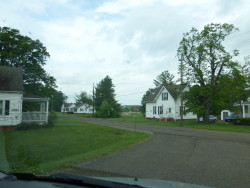My wife Karen and I just returned from a cross-country adventure that took us to eighteen different states in thirty-seven days. In addition to some book signings, our stops along the way included four National Parks (Bryce Canyon, Zion, Capitol Reef, Badlands), the Crazy Horse Memorial, and several other places too numerous to list.
One of our destinations was Fort Knox, KY, where I spent a significant portion of my career. Due to the Army’s home-stationing program, my wife was able to remain in family housing on post while I rotated into unaccompanied assignments and home again. Because of this program, we lived in the same house for nine years.
Old, poorly insulated, and needing some major repair work, we fell instantly in love with our new home. One of the upsides was that this private little dwelling sat directly across the street from the home of Victor Harkin, Director of the Fort Knox Bullion Depository.
Vic and his wife, Dot, were salt-of-the-earth people. They watched over Karen during my deployments and those many TDY trips over the years. In addition to being the Gold Vault’s Director, Vic was a retired US Army Lieutenant Colonel. In fact, on my promotion to that rank, he gave me a set of his officer’s brass.In case you’re wondering where all of this information is leading, I’ll cut to the chase. In 1977, shortly after my assignment as Operations Officer of the 194th Armor Brigade, I received a call from Vic. “Would you like to tour the vault?”
As it turns out, the national press and Congress were pressuring the Treasury Department to open the Bullion Depository’s doors. Conspiracy theorists had been stoking rumors of missing gold. (If you Google Fort Knox Gold, you’ll see that they’re still at it.) Eventually, the Post Nixon era media picked up the story. To counter the gossip, Treasury decided to grant reporters access for the first time. I guess I should be grateful to those pundits because two members of the 194th Brigade would stand in as guinea pigs for the practice run.
To accompany me, I chose the captain from the 194th’s quick reaction force. His mission would be to defend the vault should a real Goldfinger show up. Incidentally, other than correctly locating the vault in the state of Kentucky, nothing about Goldfinger was accurate. Vic met us at the door, guiding two wide-eyed soldiers to the sign-in log, and from there, on to the tour.
The most impressive thing about the vault is its door, a multi-ton monster that can’t be opened until the outer floor is lowered about two feet. (I had visions of being locked inside until our escort later pointed out an escape hatch.) Once open, the vault’s more mundane inside consisted of a series of storage rooms with certificates and wax seals on each door.
Looking through the peepholes, you could see gold bars, some bright, being made from raw gold, others dingy because they’re melted gold coins. If the seals are ever broken on those storage room doors, a joint Knox-Washington, DC team must re-inventory the contents. Imagine having to count a couple thousand ingots, each weighing twenty-seven pounds.
Some rooms contain industrial grade diamonds and white sapphires, kept in crates and ammunition boxes. They constitute our war stocks for manufacturing purposes. (Sapphires are second only to diamonds as an abrasive.) One item no longer in the national war is morphine, since it’s no longer considered the most effective painkiller. Now, the national war stocks could probably be replaced by taking up a collection along the “OxyContin Express.”
Recently, the history channel ran a documentary on the Gold vault and it was accurate, so I feel safe talking about my experience. One thing mentioned in that documentary that my tour didn’t include was the Hungarian Crown Jewels, recovered by the 86th Infantry Division near the end of WWII. (Let’s hear it for the Monuments Men.)
We were standing in for the press, and the jewels were a closely held state secret until repatriated to Hungary in January of 1978. Not showing Hungary’s precious treasure to us was obviously logical. Still, I would have loved to see them.
The basement of the depository houses a pistol range used for monthly guard qualification. It also houses a small mint. (Yes, Fort Knox is a back-up mint.) These features play a part in one of my favorite anecdotes.
A tornado swept through Brandenburg in 1974, leveling the home of one of the depository’s retirees. In those days, when employees retired, the staff melted expended brass from the range into an ingot, and painted it gold for presentation to the retiree as a memento of his or her service. While Vic and I talked about my visit to the depository, he told me about one such ingot.
After the ’74 tornado passed, a search of the retiree’s property came up empty. That means there’s a faux-ingot lying somewhere in northern Kentucky, but only God knows where. After relating this story, Vic confided, “One of these days, somebody out there will find that ingot, scrape off the gold paint, and see that it’s made of brass. When that happens, we’ll have to weather another round of…’Where’s the gold?’ “
